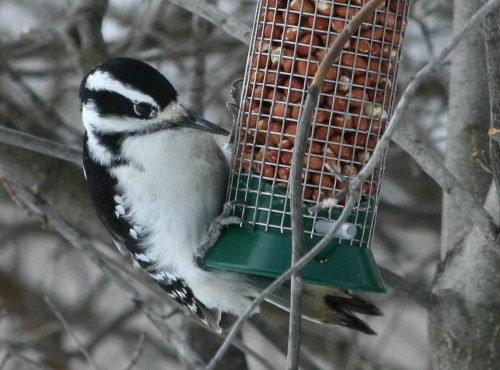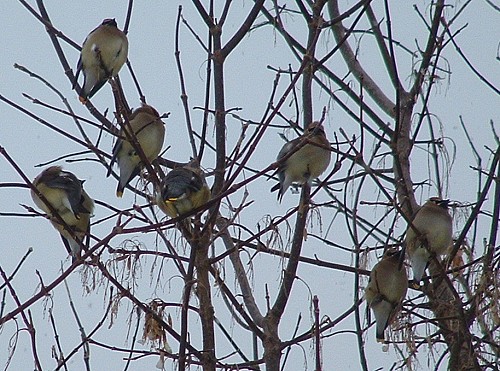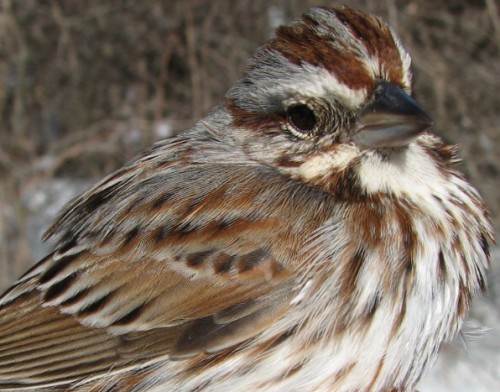Week 1: October 31-November 6, 2006
|
|
| THIS WEEK | THIS WINTER | 2006 TOTAL | SITE TOTAL | |
|---|---|---|---|---|
| # birds (and species) banded | — | — | 4203 (84) | 9256 (96) |
| # birds (and species) repeat | — | — | 650 (39) | 1528 (52) |
| # birds (and species) return | — | — | 128 (22) | 197 (26) |
| # species observed | 35 | 35 | 159 | 180 |
| # net hours | — | — | 7534.7 | 13956.8 |
| # birds banded / 100 net hours | — | — | 55.8 | 66.3 |
Note: table does not include nocturnal banding (owls).
Observers: Shawn Craik, Marcel Gahbauer
Notes: In some ways the first week of our “winter” season seems more like late fall – there are still plenty of American Robins around, snow has yet to fall, and even the ponds have still frozen only rarely. However, the drop off in species is noticeable, and reflects the fact that for the most part fall migration is indeed in the past, with only a few hardy stragglers still hanging on. Whereas 50 species were observed over the course of last week, only 35 have been spotted this week, despite almost daily visits and an attempt to seek out any lingering insectivores.
Among the highlights this week have been Ruby-crowned Kinglets and Hermit Thrushes, each seen on at least a couple of occasions, and not recorded at all last winter. There are also more Golden-crowned Kinglets and Brown Creepers hanging around than last November, but the arrival of the next cold front may well chase them out. On the other hand, sparrows of all kinds (including juncos) remain remarkably scarce. Also of note were small flocks of Horned Larks flying west over the site on both Saturday and Sunday. Activity at the feeders has been fairly quiet to date, largely thanks to the shortage of sparrows, so it was decided to take a week off from banding more birds settle in. As of Sunday, as many as 8 species were present at the feeders simultaneously, suggesting that the news of their presence is spreading in the bird world.
This will be our third year of winter population monitoring. We expect to visit the site at least 2-3 times per week, and band twice per week, weather permitting. This will allow us to again track patterns of occurrence over the course of winter, adding to our knowledge of local populations. Already our winter efforts have yielded interesting results in the form of juncos recaptured elsewhere, or returning to MBO for a second or third winter; we look forward to our next discoveries!
Week 2: November 7-13, 2006
|
|
| THIS WEEK | THIS WINTER | 2006 TOTAL | SITE TOTAL | |
|---|---|---|---|---|
| # birds (and species) banded | — | — | 4203 (84) | 9256 (96) |
| # birds (and species) repeat | — | — | 650 (39) | 1528 (52) |
| # birds (and species) return | — | — | 128 (22) | 197 (26) |
| # species observed | 24 | 38 | 159 | 180 |
| # net hours | — | — | 7534.7 | 13956.8 |
| # birds banded / 100 net hours | — | — | 55.8 | 66.3 |
Note: table does not include nocturnal banding (owls).
Observers: Barbara Frei, Shawn Craik, Marcel Gahbauer, Marie-Anne Hudson
Notes: Not much to comment on this week – it was another dismally wet period, and attempts at banding were again washed out. A few more species were added to this year’s winter list, namely Ring-billed Gull, Rock Pigeon, and Common Raven. Activity at the feeders is gradually picking up, though it still seems quieter than at this time in 2004 and 2005 (but that may be due to it being warmer and rainier than in those years).
Week 3: November 14-20, 2006
|
|
| THIS WEEK | THIS WINTER | 2006 TOTAL | SITE TOTAL | |
|---|---|---|---|---|
| # birds (and species) banded | 20 (6) | 20 (6) | 4223 (84) | 9276 (96) |
| # birds (and species) repeat | 8 (3) | 8 (3) | 658 (39) | 1536 (52) |
| # birds (and species) return | — | — | 128 (22) | 197 (26) |
| # species observed | 23 | 39 | 159 | 180 |
| # net hours | 12.0 | 12.0 | 7546.7 | 13968.8 |
| # birds banded / 100 net hours | 166.7 | 166.7 | 56.0 | 66.4 |
Note: table does not include nocturnal banding (owls).
Bander-in-charge: Marcel Gahbauer Assistants: Natalia Castellanos, Victoria Chang, Shawn Craik, Jean Demers, Valerie Francella, Sabrina Gosselin, Gay Gruner, Chris Murphy, Troy Pretzlaw, Greg Rand, Sabrina Richard-Lalonde, Clemence Soulard
Notes: It was yet another wet week at MBO, also unseasonably warm for several days, though cooling down to seasonal temperatures by the end of the week. The flooding now appears to be as extensive at this time last fall, which does not bode well for spring conditions at the site.
Despite the weather, we were finally were able to get in our first winter banding session on Sunday morning. To our surprise, a large flock of House Finches has taken residence – there were close to 50 in the area, a number we haven’t seen in nearly two years. Not surprisingly, they were the most numerous bird banded that day, with 9 birds, eclipsing our total for the species over the past 18 months! In contrast, American Goldfinches remain unusually scarce, as they have been throughout the fall; we hope they will turn up as the winter progresses. By this time last winter, we had already banded 64 goldfinches – though to be fair, we had drier weather and were able to band on several occasions earlier in the season.
The other banding highlight of the day was a male Northern Cardinal, banded during our Fall Migration Monitoring Program in late August. It nicely illustrated an interesting quirk of songbird ageing that applies to this and a few other species in which individuals of all ages undergo a full moult in the late summer / early fall. Whereas this bird was easily recognizable as a juvenile at the time of banding, it has now completed its moult, and is indistinguishable from older cardinals – i.e., were it not for the band, we would now be unable to tell its age, despite being able to do so three months ago!
Week 4: November 21-27, 2006
|
|
| THIS WEEK | THIS WINTER | 2006 TOTAL | SITE TOTAL | |
|---|---|---|---|---|
| # birds (and species) banded | 21 (7) | 41 (8) | 4244 (84) | 9297 (96) |
| # birds (and species) repeat | 5 (3) | 13 (5) | 663 (39) | 1541 (52) |
| # birds (and species) return | 1 (1) | 1 (1) | 129 (22) | 198 (26) |
| # species observed | 26 | 43 | 159 | 180 |
| # net hours | 23.0 | 35.0 | 7569.7 | 13991.8 |
| # birds banded / 100 net hours | 91.3 | 117.1 | 56.1 | 66.4 |
Note: table does not include nocturnal banding (owls).
Banders-in-charge: Marcel Gahbauer, Marie-Anne Hudson Assistants: Shawn Craik, Jean Demers, Sabrina Gosselin, Gay Gruner, Betsy McFarlane, Chris Murphy, Greg Rand, Clemence Soulard
Notes: Considering our frequent complaints about weather in recent weeks, it’s only fair to begin this report by saying that conditions were actually very pleasant for most of the week, with lots of sunny skies, seasonal temperatures, and minimal wind. As a result, we were able to complete our two scheduled weekly banding sessions for the first time this winter season.
That being said, the banding results were not overwhelming. Both on Wednesday and Sunday, a decent number of birds were in the area, but it seemed like a lot of them were doing a good job of avoiding the nets! Of course that’s always the case to some extent – we just notice it more in winter when our focus is on this one clump of nets, from which we can see the coming and going of birds better than at most locations during migration monitoring. We know that on any given day we’ll miss a good percentage of the birds using the feeders, but over the course of the season we should be able to get a fair sample of the birds overwintering at MBO.
Most numerous among the species banded this week were House Finch (7), Slate-coloured Junco (5), and Mourning Dove (3) – quite a different list from fall. Chickadees remain relatively scarce, with only 3 previously banded individuals being recaptured this week.
A few more species were added to the winter sightings list this week. A Northern Harrier was seen during Wednesday’s banding session, and the raptor list grew further on Thursday, when a Merlin was observed perched in a hawthorn with a view of the feeders throughout the census period. On Sunday, a Great Blue Heron was spotted gliding southward over the west slope, and a high-flying flock of scaup went past right overhead. They might easily have been missed had it not been for all the time we were spending looking up and counting the seemingly endless flocks of Canada Geese – over 1000 for the day, remarkable for this late in the year. To put this in context, last November Canada Geese were observed on only 5 of the 14 days during which observations were made at MBO, and the peak number among those was just 28! Needless to say, it was easy for all present on Sunday to agree that it isn’t feeling much like winter yet (though lest Mother Nature think otherwise and try to settle the score, that was hardly meant as a complaint!)
Week 5: November 28 – December 4, 2006
|
|
| THIS WEEK | THIS WINTER | 2006 TOTAL | SITE TOTAL | |
|---|---|---|---|---|
| # birds (and species) banded | — | 41 (8) | 4244 (84) | 9297 (96) |
| # birds (and species) repeat | — | 13 (5) | 663 (39) | 1541 (52) |
| # birds (and species) return | — | 1 (1) | 129 (22) | 198 (26) |
| # species observed | 22 | 44 | 159 | 180 |
| # net hours | — | 35.0 | 7569.7 | 13991.8 |
| # birds banded / 100 net hours | — | 117.1 | 56.1 | 66.4 |
Note: table does not include nocturnal banding (owls).
Observers: Marcel Gahbauer, Gay Gruner, Chris Murphy
Notes: We skipped banding this week, partly because suitable weather was limited, but also because much of our time was devoted to preparing a workshop on ageing that we held on December 2. For 5 hours on Saturday afternoon, MBO banders Marcel Gahbauer and Marie-Anne Hudson led 23 workshop participants through the process of learning to age birds by moult limits and other feather characteristics. We were fortunate to have on hand the specimen collection from the Canadian Bird Banding Office, which we used to illustrate comparisons among species, and to quiz everyone at the end of the day. We were very impressed not only with the large turnout, but also with everyone’s enthusiasm, and especially with how well the lessons were absorbed. It’s exciting for us to have such an eager and capable group of banders in training, and we look forward to holding further workshops on more advanced topics, as well as supplementing these with more hands-on training during banding sessions.
Notable sightings for the week included the winter season’s first Red-shouldered Hawk, as well as another Northern Harrier and a sighting of the (presumably) local Red-tailed Hawk and Northern Shrike. Canada Geese remain remarkably abundant, with 379 recorded on the Thursday morning census. House Finches are still the most abundant species at the feeders, with 39 observed the same morning.
Week 6: December 5-11, 2006
|
|
| THIS WEEK | THIS WINTER | 2006 TOTAL | SITE TOTAL | |
|---|---|---|---|---|
| # birds (and species) banded | 3 (3) | 44 (8) | 4247 (84) | 9300 (96) |
| # birds (and species) repeat | 4 (2) | 17 (5) | 667 (39) | 1545 (52) |
| # birds (and species) return | — | 1 (1) | 129 (22) | 198 (26) |
| # species observed | 20 | 46 | 159 | 180 |
| # net hours | 11 | 46.0 | 7580.7 | 14002.8 |
| # birds banded / 100 net hours | 27.3 | 95.7 | 56.0 | 66.4 |
Note: table does not include nocturnal banding (owls).
Bander-in-charge: Marie-Anne Hudson Assistants: Jean Beaudreault, Sophie Cauchon, Shawn Craik, Barbara Frei, Marcel Gahbauer, Gay Gruner, Betsy Mcfarlane, Andre Pelletier, Katleen Robert
Notes: For a couple of days this week it was very cold; at other times it remained unseasonably mild but again wet. At least we were able to squeeze in one attempt at banding this week, but gusty winds severely hampered the effectiveness of the nets, with just 3 new birds banded, and another 4 repeats. Nonetheless, it was good to get back out and into action. Another two species were added to the winter 2006/07 list, with a Great Black-backed Gull spotted flying overhead on Saturday, and two Snow Geese in the skies the following day. The big story though remains the phenomenal number of Canada Geese still in the area – 935 counted on Saturday, and 1600 on Sunday! Mallards are also still present in large numbers, reflecting the late start to winter this year.
Week 7: December 12-18, 2006
|
|
| THIS WEEK | THIS WINTER | 2006 TOTAL | SITE TOTAL | |
|---|---|---|---|---|
| # birds (and species) banded | 18 (6) | 62 (9) | 4265 (84) | 9318 (96) |
| # birds (and species) repeat | 4 (2) | 21 (5) | 671 (39) | 1549 (52) |
| # birds (and species) return | 2 (1) | 3 (1) | 131 (22) | 200 (26) |
| # species observed | 31 | 48 | 159 | 180 |
| # net hours | 20 | 66.0 | 7600.7 | 14022.8 |
| # birds banded / 100 net hours | 90.0 | 93.9 | 56.1 | 66.4 |
Note: table does not include nocturnal banding (owls).
Bander-in-charge: Marcel Gahbauer Assistants: Jean Beaudreault, Sophie Cauchon, Shawn Craik, Barbara Frei, Gay Gruner, Andre Pelletier, Greg Rand, Katleen Robert
Notes: What a week! Temperatures were above seasonal for the whole week, and ridiculously warm for a few days, with temperatures in the double digits under calm and largely sunny skies. Much nicer, in fact, than on most of the days in October when we were still doing daily migration monitoring! We had to keep checking our calendars to believe it is mid-December.
We took advantage of the conditions to enjoy a couple of mornings of banding, plus a couple of additional leisurely walks around the site. All were productive, but Thursday really stood out. Only 6 times previously in the three winters at MBO have we managed to spot 20 species in a day, and never more than 23. Well, on Thursday we got to 21 species in the first 25 minutes, a pace that would be quite decent even during most of migration. Over the course of the morning, we gradually added more, until we ended up with a new record of 29, which we expect will last a long while. Among the unlikely contributors to the list, considering it is mid-December, were over 2500 Canada Geese, nearly 200 Mallards, a baker’s dozen of Black Ducks, 4 raptor species (Sharp-shinned, Cooper’s, Red-tailed Hawks, and Harrier), and nearly 30 Robins. Also seen were 2 Snow Geese that were spotted hanging out with the Canada Geese most days this week. A surprise on Friday was a Song Sparrow hanging out near the parking circle – unbanded, and therefore probably not one of our locals.
The only downside to the warm weather is that the birds don’t show much interest in the feeders when natural food sources are available all around. As a result, our banding numbers were fairly modest, but the slower pace enabled several of our eager trainees to continue advancing their skills without feeling too much time pressure, and everyone simply relished the chance to spend a few hours at MBO under these prematurely spring-like conditions.
While we haven’t been seeing a frenzy at the feeders yet, there are signs that they could get very busy once we get some snow. On Friday morning, an amazingly large flock of American Tree Sparrows was observed foraging along the edge of the neighbouring field, the 43 birds easily representing a record count for that species at MBO in any season. Also, while American Goldfinches have been unusually scarce for several months, they have been seen in larger flocks of late, and some of them were finally banded on Friday. They were a considerate bunch too, offering up HY-male, HY-female, AHY-male, and AHY-female among just 5 birds, for some lovely comparisons to help refresh the memory on these sometimes tricky birds.
With the addition of Sharp-shinned Hawk and Herring Gull to this year’s winter list, we have now seen 48 species at MBO since the beginning of November. In comparison, we didn’t reach that mark until mid-February last winter. However, that may largely reflect the almost complete absence of snow to date, and by the time winter ends (for us) in late March, the totals for the two seasons may well end up being quite similar.
Week 8: December 19-25, 2006
|
|
| THIS WEEK | THIS WINTER | 2006 TOTAL | SITE TOTAL | |
|---|---|---|---|---|
| # birds (and species) banded | — | 62 (9) | 4265 (84) | 9318 (96) |
| # birds (and species) repeat | — | 21 (5) | 671 (39) | 1549 (52) |
| # birds (and species) return | — | 3 (1) | 131 (22) | 200 (26) |
| # species observed | 20 | 48 | 159 | 180 |
| # net hours | — | 66.0 | 7600.7 | 14022.8 |
| # birds banded / 100 net hours | — | 93.9 | 56.1 | 66.4 |
Note: table does not include nocturnal banding (owls).
Observers: Shawn Craik, Marie-Anne Hudson
Notes: It was a quiet week for observations at MBO as everyone took some well deserved time off for the holidays. Temperatures also returned to a more seasonal level this week, so the birds were not quite as active and vocal as during last week’s spring-like conditions. Next week will likely also remain quiet around here, but we will continue to at least fill the feeders and report on any noteworthy sightings.
Week 9: December 26, 2006 – January 1, 2007
|
|
| THIS WEEK | THIS WINTER | 2006 TOTAL | SITE TOTAL | |
|---|---|---|---|---|
| # birds (and species) banded | — | 62 (9) | 4265 (84) | 9318 (96) |
| # birds (and species) repeat | — | 21 (5) | 671 (39) | 1549 (52) |
| # birds (and species) return | — | 3 (1) | 131 (22) | 200 (26) |
| # species observed | 14 | 48 | 159 | 180 |
| # net hours | — | 66.0 | 7600.7 | 14022.8 |
| # birds banded / 100 net hours | — | 93.9 | 56.1 | 66.4 |
Note: table does not include nocturnal banding (owls).
Observer: Marcel Gahbauer
Notes: Happy New Year! It was another quiet week at MBO, with snow finally arriving on Tuesday, bringing with it a change in the community of birds – the Canada Geese have moved on at last (though they are still in the region, with several thousand counted on Sunday’s Christmas Bird Count in Hudson), while the Juncos, Goldfinches, and Chickadees seem to have settled in at the feeders, emptying them at a much quicker pace than earlier this season.
Though only marginally ahead of 2005, 2006 set new records for the number of birds banded in a year at MBO, as well as the number of repeats. In every respect, 2006 was a great year for MBO, and we would like to thank all those who made it possible – Mountain Equipment Co-op, the James L. Baillie Memorial Fund of Bird Studies Canada, Bird Protection Quebec, and Canada Steamship Lines for providing the funding that enabled us to for the first time accomplish complete coverage of our spring migration season in addition to fall; to Banders-in-charge Barbara Frei, Marcel Gahbauer, Marie-Anne Hudson, and Seabrooke Leckie for putting in long hours coordinating the banding operations throughout the year; and especially to the over 100 volunteers who put in time helping with banding (and/or maintenance projects) at MBO over the past twelve months. A research program of this scope is impossible without such support; we hope that the experience has been as rewarding for all sponsors and participants as it has been for us as coordinators/researchers, and that we can count on everyone’s continued involvement in 2007 and beyond!
Week 10: January 2-8, 2007
|
|
| THIS WEEK | THIS WINTER | 2007 TOTAL | SITE TOTAL | |
|---|---|---|---|---|
| # birds (and species) banded | 14 (4) | 76 (9) | 14 (4) | 9332 (96) |
| # birds (and species) repeat | 5 (2) | 26 (6) | 5 (2) | 1554 (52) |
| # birds (and species) return | 2 (1) | 5 (1) | 2 (1) | 202 (26) |
| # species observed | 21 | 48 | 21 | 180 |
| # net hours | 15.0 | 66.0 | 15.0 | 14037.8 |
| # birds banded / 100 net hours | 93.3 | 93.9 | 93.3 | 66.5 |
Note: table does not include nocturnal banding (owls).
Banders-in-charge: Marcel Gahbauer, Marie-Anne Hudson Assistants: Jean Beaudreault, Natalia Castellanos, Sophie Cauchon, Victoria Chang, Val Francella, Barbara Frei, Sabrina Gosselin, Betsy Mcfarlane, Andre Pelletier, Greg Rand, Sabrina Richard-Lalonde, Katleen Robert
Notes: We actually managed to get our two days of banding in this week thanks to the continued unseasonably warm weather this winter has provided thus far. Gusting winds and the lack of snow, however, made our total catch somewhat modest. In fact on Sunday, there were six times as many volunteers on site than birds banded! On the other hand, under calmer conditions on Wednesday, the birds outnumbered people by a 12:1 ratio. We didn’t mind the Sunday outcome though, because we were outside on such a beautiful day, and took advantage of the quiet nets to walk around the site and spot our local young male Cooper’s Hawk hanging out by the D nets. The birds at the feeders were unimpressed when he buzzed them later in the morning. American Goldfinches (finally arriving in good numbers) and Black-capped Chickadees (surprisingly many ‘new’ birds) were this week’s top banded species, with six each.
Weeks 11/12: January 9-22, 2007
|
|
| THIS WEEK | THIS WINTER | 2007 TOTAL | SITE TOTAL | |
|---|---|---|---|---|
| # birds (and species) banded | — | 76 (9) | 14 (4) | 9332 (96) |
| # birds (and species) repeat | — | 26 (6) | 5 (2) | 1554 (52) |
| # birds (and species) return | — | 5 (1) | 2 (1) | 202 (26) |
| # species observed | 13 | 48 | 23 | 180 |
| # net hours | — | 81.0 | 15.0 | 14037.8 |
| # birds banded / 100 net hours | — | 93.9 | 93.3 | 66.5 |
Note: table does not include nocturnal banding (owls).
Observer: Shawn Craik
Notes: Weather has not permitted for any banding during these two weeks, and observed bird activity was relatively quiet aside from a lock of 20+ House Finches regularly observed around the feeder area. However, the lack of snow in week 11 allowed for walking a portion of the census trail, with the highlight being a group of 3 American Robins along the path behind the cabin. Following the snowstorm on January 15, bird activity around the feeders appeared to pick up. In particular, there was a marked increase in the number of juncos attending the feeder area. The higher level of bird activity may have attracted the Northern Shrike that was seen perched near the A nets just west of the feeders.
Weeks 13: January 23-29, 2007
|
|
| THIS WEEK | THIS WINTER | 2007 TOTAL | SITE TOTAL | |
|---|---|---|---|---|
| # birds (and species) banded | — | 76 (9) | 14 (4) | 9332 (96) |
| # birds (and species) repeat | — | 26 (6) | 5 (2) | 1554 (52) |
| # birds (and species) return | — | 5 (1) | 2 (1) | 202 (26) |
| # species observed | 9 | 48 | 24 | 180 |
| # net hours | — | 81.0 | 15.0 | 14037.8 |
| # birds banded / 100 net hours | — | 93.9 | 93.3 | 66.5 |
Note: table does not include nocturnal banding (owls).
Observer: Shawn Craik
Notes: Another week has passed where the mercury in the thermometer has held pretty steady at -15 degrees Celsius (or thereabouts) throughout the day, meaning it has remained far too cold for banding. Otherwise the weather has been beautiful, with sunshine virtually every day, making for great hiking conditions. A walk around the site produced the above photo, as well as evidence of other mammals, including white-tailed deer and squirrel. Although the Northern Shrike was not observed this week, a Sharp-shinned Hawk and Cooper’s Hawk were seen perched near the pond and front gate, respectively.
The feeders have been attracting the usual suspects including Black-capped Chickadees, Slate-coloured Juncos, and American Tree Sparrows. A highlight included a pair of White-breasted Nuthatches feeding in the forest along the road leading to the cabin. Finch activity was considerably slower this week.
McGill University’s undergraduate ethology class participated in a bird feeder laboratory at MBO on Tuesday and Wednesday. The goal of the lab was to determine whether Black-capped Chickadees prefer to feed on black oil sunflower, grey-striped sunflower, or safflower seeds. Each food type was presented in a different feeder. Stay tuned for results.
Weeks 14-15: January 30 – February 12, 2007
|
|
| THIS WEEK | THIS WINTER | 2007 TOTAL | SITE TOTAL | |
|---|---|---|---|---|
| # birds (and species) banded | — | 76 (9) | 14 (4) | 9332 (96) |
| # birds (and species) repeat | — | 26 (6) | 5 (2) | 1554 (52) |
| # birds (and species) return | — | 5 (1) | 2 (1) | 202 (26) |
| # species observed | 16 | 48 | 25 | 180 |
| # net hours | — | 81.0 | 15.0 | 14037.8 |
| # birds banded / 100 net hours | — | 93.9 | 93.3 | 66.5 |
Note: table does not include nocturnal banding (owls).
Observers: Sophie Cauchon, Shawn Craik, Barbara Frei, Marie-Anne Hudson, Andre Pelletier
Notes: Frigid temperatures throughout this two-week period continued to postpone banding activities. There were no major changes in species composition near the feeder area, as Black-capped Chickadees, Slate-coloured Juncos, American Tree Sparrows, and Mourning Doves were the usual suspects at and under the feeders. However, observation highlights included the regular viewing of an adult Red-tailed Hawk and an extremely vocal group of 20-25 House Finches. Also of note was the surprising absence of northern Cardinals – only a single male was observed throughout the two-week period.
Week 16: February 13-19, 2007
|
|
| THIS WEEK | THIS WINTER | 2007 TOTAL | SITE TOTAL | |
|---|---|---|---|---|
| # birds (and species) banded | — | 76 (9) | 14 (4) | 9332 (96) |
| # birds (and species) repeat | — | 26 (6) | 5 (2) | 1554 (52) |
| # birds (and species) return | — | 5 (1) | 2 (1) | 202 (26) |
| # species observed | 7 | 48 | 25 | 180 |
| # net hours | — | 81.0 | 15.0 | 14037.8 |
| # birds banded / 100 net hours | — | 93.9 | 93.3 | 66.5 |
Note: table does not include nocturnal banding (owls).
Observers: Sophie Cauchon, Shawn Craik, Marie-Anne Hudson, Andre Pelletier
Notes: It was an extremely quiet week with no banding and a low number of species observed, likely a result of several factors, including just two site visits, one of which occurred near dusk.
We received results regarding the bird feeder lab that was completed at MBO by McGill University’s ethology class in late January. Over the course of two days the class observed a total of 376 foraging attempts by Black-capped Chickadees at three identical-style feeders. Each feeder contained one of three seed types: black oil sunflower, grey-striped sunflower, and safflower. Of the 376 feeding attempts, 370 were directed at black oil sunflower whereas only five were made at grey-striped sunflower, and one at safflower. These results are consistent with findings of the feeding experiment that was carried out by the ethology class over the previous four years. This year’s lab group also collected a small amount of feeding data on American Tree Sparrow, Slate-coloured Junco, and Northern Cardinal. Similar to the chickadees, these three species showed an overall preference for black oil sunflower seeds.
Week 17: February 20-26, 2007
|
|
| THIS WEEK | THIS WINTER | 2007 TOTAL | SITE TOTAL | |
|---|---|---|---|---|
| # birds (and species) banded | — | 76 (9) | 14 (4) | 9332 (96) |
| # birds (and species) repeat | — | 26 (6) | 5 (2) | 1554 (52) |
| # birds (and species) return | — | 5 (1) | 2 (1) | 202 (26) |
| # species observed | 12 | 48 | 25 | 180 |
| # net hours | — | 81.0 | 15.0 | 14037.8 |
| # birds banded / 100 net hours | — | 93.9 | 93.3 | 66.5 |
Note: table does not include nocturnal banding (owls).
Observer: Shawn Craik
Notes: Another winter week has passed with no banding information to share. However, seasonally warm temperatures are predicted to continue so we hope to try banding later this week. Observation highlights included a flock of 13 Canada Geese flying low over the corn field on Thursday. This is an interesting sighting given that nearby Lac St-Louis has been frozen for over a month and that current snow cover in the field would restrict feeding of geese on waste grain. It marks the first February record of Canada Goose at MBO. Feeder activity was dominated by American Tree Sparrows, Black-capped Chickadees, Slate-coloured Juncos, and Mourning Doves. The flock (>15 birds) of House Finches remained in the area.
Week 18: February 27 – March 5, 2007
|
|
| THIS WEEK | THIS WINTER | 2007 TOTAL | SITE TOTAL | |
|---|---|---|---|---|
| # birds (and species) banded | 5 (4) | 81 (9) | 19 (5) | 9337 (96) |
| # birds (and species) repeat | 1 (1) | 27 (6) | 6 (2) | 1555 (52) |
| # birds (and species) return | 1 (1) | 6 (1) | 3 (2) | 203 (26) |
| # species observed | 20 | 48 | 28 | 180 |
| # net hours | 0 | 85.0 | 19.0 | 14041.8 |
| # birds banded / 100 net hours | 125.0 | 95.3 | 100.0 | 66.5 |
Note: table does not include nocturnal banding (owls).
Bander: Marie-Anne Hudson Assistants: Natalia Castellanos, Shawn Craik, Jean Demers, David Fishman, Sabrina Gosselin, Gay Gruner, Betsy McFarlane, Greg Rand, Clemence Soulard
Notes: Heavy snowfalls late in week 18 made the feeders very attractive, giving rise to promising banding conditions. Unfortunately the wind didn't agree and picked up after about 45 minutes of having set the nets up, so they were quickly taken down. Still, we managed to band 5 individuals of 4 different species: House Sparrow, Slate-colored Junco, Black-capped Chickadee and American Goldfinch, and had a return Slate-colored Junco that was banded in late November. This suggests that this young male has stuck around MBO throughout the winter, gorging himself on our seeds.
The other weekly observations were pretty much in-line with what we've seen this winter, with the exception of an American Robin on Monday. Despite the deep snowdrifts, signs of spring are beginning to appear with singing Northern Cardinals, an extremely vocal Red-shouldered Hawk, and 3 unidentified icterids in the big dead tree on Sunday. It is the first time in a while that we've recorded 20 species in a week. Hopefully the weather will give us a bit of a break and let us gear up for the spring season, which is just around the corner!
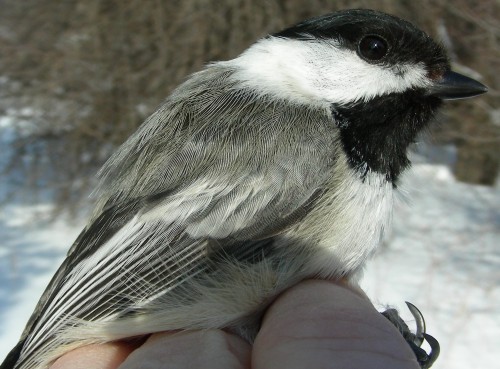 This little chickadee made us look twice. Chickadees are notoriously difficult to age at the best of times, and it really doesn't help when one side of the tail indicates an after-second year bird, and the other indicates a second-year bird. The lesson of the day: always look at the full tail! (Photo by Marie-Anne Hudson)
This little chickadee made us look twice. Chickadees are notoriously difficult to age at the best of times, and it really doesn't help when one side of the tail indicates an after-second year bird, and the other indicates a second-year bird. The lesson of the day: always look at the full tail! (Photo by Marie-Anne Hudson)
Week 19: March 6-12, 2007
|
|
|
|||||
| # birds (and species) banded |
5 (3)
86 (10)
24 (6)
9342 (96)
# birds (and species) repeat
1 (1)
28 (6)
7 (2)
1556 (52)
# birds (and species) return
—
6 (1)
3 (2)
203 (26)
# species observed
17
48
29
180
# net hours
6
91.0
25.0
14047.8
# birds banded / 100 net hours
83.3
94.5
96.0
66.5
Note: table does not include nocturnal banding (owls)
Bander: Marie-Anne Hudson Observers and assistants: Shawn Craik, Gay Gruner, Betsy McFarlane
Notes: With rising temperatures possibly indicating that spring is just around the corner, we managed to squeeze a banding session in at the end of this week, netting 5 new birds and 1 recap in just under 2 hours. The wind made us close a little early and made for some very springy nets. We could have easily doubled the number of birds banded had the wind cooperated – but there will be plenty of time for that in the coming weeks as we gear up for the spring season. The Red-shouldered Hawk was calling intermittently throughout the morning, but our suspicions will only be laid to rest once we actually SEE it, since we have some extremely talented Blue Jays in the area. Fortunately the bird was calling from very high up in the sky, indicating that it was likely our local breeding pair setting up its yearly territory. Observation highlights included a Northern Harrier and Herring Gull, the first observations of these species at MBO for 2007. Shawn would like to warn anyone who may be considering going for a walk on the site’s ponds – by his experience, you may get wet!
Weeks 20: March 13-19, 2007
|
|
|
|||||||||||||||||||||||||||||||||||
|
Note: table does not include nocturnal banding (owls) |
Observers:Sophie Cauchon, Shawn Craik, Gay Gruner, Andre Pelletier, Greg Rand
Notes: Although we did not have the chance to do any banding this week, observations indicated considerable activity around the feeders. Of particular interest were 2 Common Grackles (first observation of this species this winter) and at least 13 Northern Cardinals gorging themselves at the feeders. However, Black-capped Chickadees and American Tree Sparrows remained most abundant around the feeder area. Other highlights throughout week 20 included flocks of Cedar Waxwings and Canada Geese and at least 2 individuals of the 3 common woodpecker species: Downy, Hairy, and Pileated. With southern winds forecasted for later this week, we anticipate the arrival of additional early migrants, including Red-winged Blackbirds, to MBO soon.
Week 21: March 20-27, 2007
|
|
|
|||||
| # birds (and species) banded |
17 (5)
103 (12)
41 (8)
9359 (96)
# birds (and species) repeat
5 (2)
33 (7)
12 (3)
1561 (52)
# birds (and species) return
1 (1)
7 (1)
4 (2)
204 (26)
# species observed
20
49
32
180
# net hours
12
103.0
37.0
14059.8
# birds banded / 100 net hours
116.7
97.1
110.8
66.5
Note: table does not include nocturnal banding (owls)
Bander-in-charge: Barbara Frei Observers: Natalia Castellanos, Shawn Craik, Valerie Francella, Gay Gruner, Betsy McFarlane, Greg Rand
Notes: Despite a fresh blanket of snow that fell on Saturday evening, we were fortunate on Sunday to have the opportunity to band a final time during the winter monitoring season and bring our winter total of banded birds to 100. Other highlights on Sunday included the first observation (and subsequent banding) of a Song Sparrow for 2007 and a considerable increase in the number of observed Ring-billed Gulls. The first Red-winged Blackbirds of 2007 were seen on Friday afternoon. With the winter monitoring season officially behind us, it is now time to begin spring migration monitoring, which gets underway with a census on March 28th!
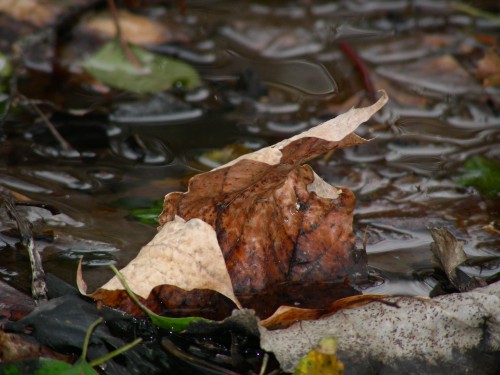 A sign of the changing seasons – fallen leaves in the half-frozen creek in the back woods along the census trail on Sunday morning. (Photo by Marcel Gahbauer)
A sign of the changing seasons – fallen leaves in the half-frozen creek in the back woods along the census trail on Sunday morning. (Photo by Marcel Gahbauer)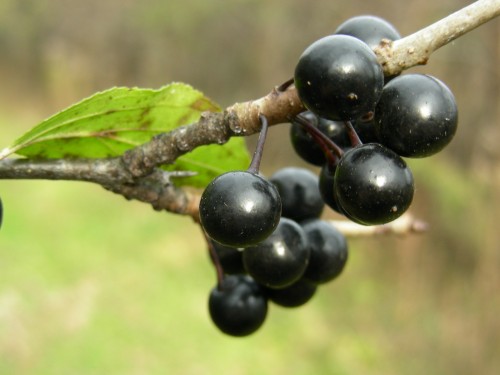 American Robins are still present in large numbers daily, no doubt in large part due to the rich crop of buckthorn berries across much of the site. (Photo by Marcel Gahbauer)
American Robins are still present in large numbers daily, no doubt in large part due to the rich crop of buckthorn berries across much of the site. (Photo by Marcel Gahbauer)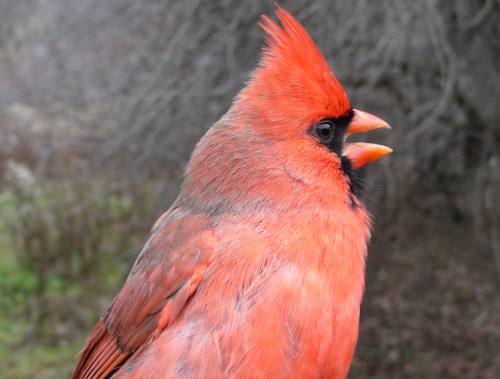 Winter banding finally got off to a good start on Sunday. Among the birds captured was this male Northern Cardinal, banded at MBO in late August this year as a juvenile. (Photo by Marcel Gahbauer)
Winter banding finally got off to a good start on Sunday. Among the birds captured was this male Northern Cardinal, banded at MBO in late August this year as a juvenile. (Photo by Marcel Gahbauer)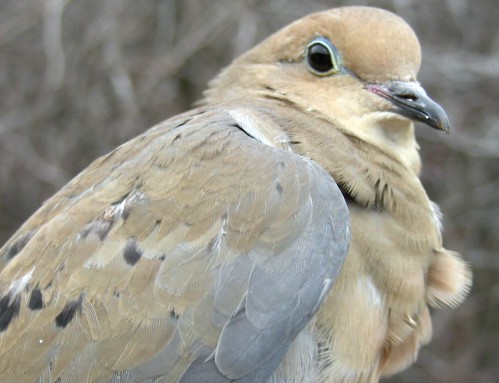 Mourning Doves are always a pleasant surprise when banding. This young female has already had an eventful life, as a routine check for fat deposits revealed extensive scarring on the upper breast, presumably evidence of a narrow escape from a predator. The wound appeared fully healed, and the bird was in condition. (Photo by Marcel Gahbauer)
Mourning Doves are always a pleasant surprise when banding. This young female has already had an eventful life, as a routine check for fat deposits revealed extensive scarring on the upper breast, presumably evidence of a narrow escape from a predator. The wound appeared fully healed, and the bird was in condition. (Photo by Marcel Gahbauer)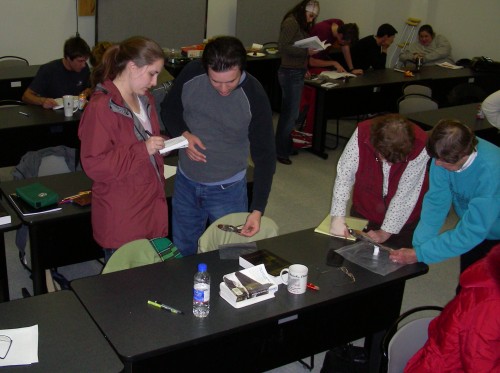 Some of the participants in the first MBO ageing workshop poring over specimens and notes during the quiz. (Photo by Marie-Anne Hudson)
Some of the participants in the first MBO ageing workshop poring over specimens and notes during the quiz. (Photo by Marie-Anne Hudson)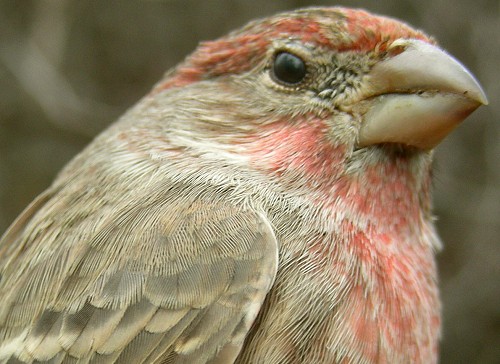 So far it is still very much the winter of the House Finch at MBO – they account for over one third of the birds we have banded, and are routinely the most abundant species at the feeders. (Photo by Marcel Gahbauer)
So far it is still very much the winter of the House Finch at MBO – they account for over one third of the birds we have banded, and are routinely the most abundant species at the feeders. (Photo by Marcel Gahbauer)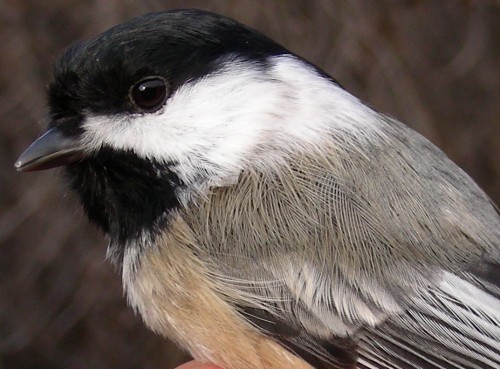 The return of an old friend this week – this Black-capped Chickadee was the first bird banded when we launched operations on September 19, 200 Although recaptured a number of times since, this was its first visit since February. An after-hatch-year bird even at the time of banding, it is now at least 3-1/2 years old … and still feisty as ever! (Photo by Marcel Gahbauer)
The return of an old friend this week – this Black-capped Chickadee was the first bird banded when we launched operations on September 19, 200 Although recaptured a number of times since, this was its first visit since February. An after-hatch-year bird even at the time of banding, it is now at least 3-1/2 years old … and still feisty as ever! (Photo by Marcel Gahbauer)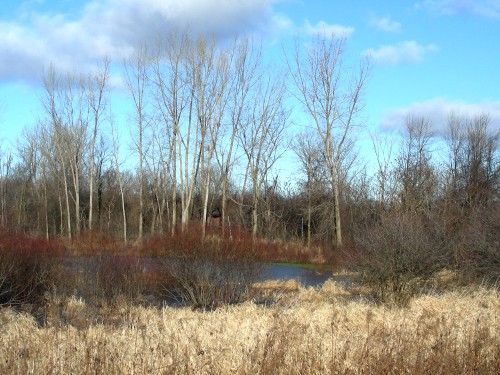 Not a typical winter scene in most years, but this is a rather representative view of the back pond at MBO this December, as viewed from near net H2. (Photo by Marcel Gahbauer)
Not a typical winter scene in most years, but this is a rather representative view of the back pond at MBO this December, as viewed from near net H2. (Photo by Marcel Gahbauer)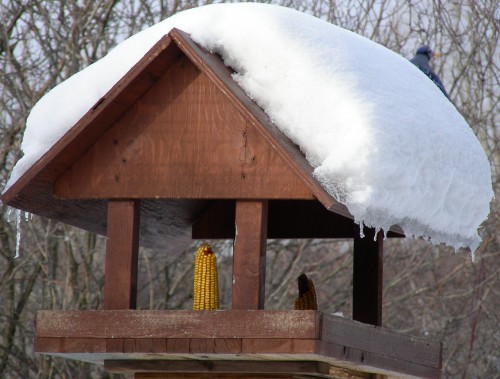 Winter has arrived at last! Bird activity at the feeders seems to have picked up as a result, with visitors including this somewhat shy Blue Jay, hanging out on the snowy “roof” of the feeder after prying loose a kernel of corn. (Photo by Marcel Gahbauer)
Winter has arrived at last! Bird activity at the feeders seems to have picked up as a result, with visitors including this somewhat shy Blue Jay, hanging out on the snowy “roof” of the feeder after prying loose a kernel of corn. (Photo by Marcel Gahbauer)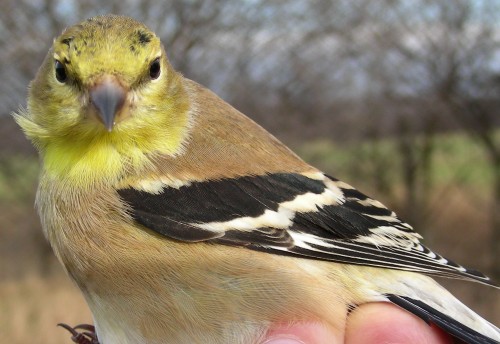 Last week we wrote that winter has arrived at last; the photo above shows that it quickly disappeared again! Not only is the landscape entirely brown and green, but the male American Goldfinches are already starting to acquire their black caps for spring! (Photo by Marcel Gahbauer)
Last week we wrote that winter has arrived at last; the photo above shows that it quickly disappeared again! Not only is the landscape entirely brown and green, but the male American Goldfinches are already starting to acquire their black caps for spring! (Photo by Marcel Gahbauer)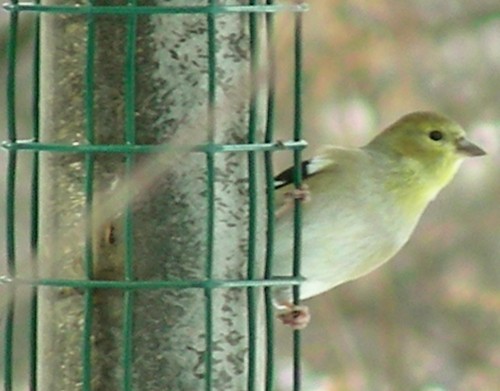 With a bit more snow and colder temperatures at last, the American Goldfinches are becoming a more regular sight on the nyjer seed feeders. (Photo by Marcel Gahbauer)
With a bit more snow and colder temperatures at last, the American Goldfinches are becoming a more regular sight on the nyjer seed feeders. (Photo by Marcel Gahbauer)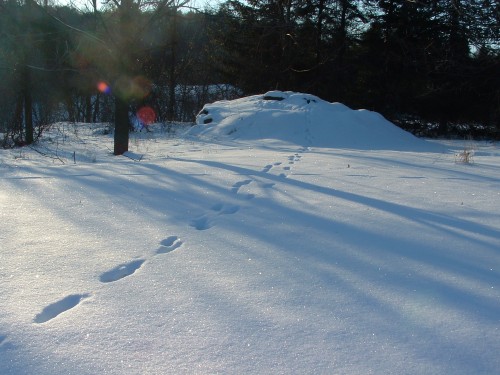 These mammal (either coyote or fox) tracks leading into the snake hibernaculum near the front gate are the only signs that these wild canines are present at MBO. Although widespread (foxes) and on the increase (coyotes) on the island of Montreal, both species are remarkably adept at staying out of sight. (Photo by Shawn Craik)
These mammal (either coyote or fox) tracks leading into the snake hibernaculum near the front gate are the only signs that these wild canines are present at MBO. Although widespread (foxes) and on the increase (coyotes) on the island of Montreal, both species are remarkably adept at staying out of sight. (Photo by Shawn Craik)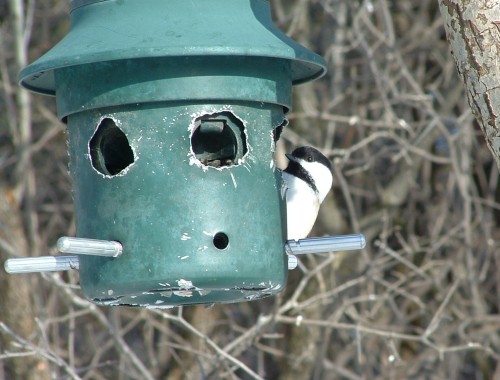 One of the ever-ravenous Black-capped Chickadees returning to the green tube feeder for more sunflower seeds on February 7. (Photo by Barbara Frei)
One of the ever-ravenous Black-capped Chickadees returning to the green tube feeder for more sunflower seeds on February 7. (Photo by Barbara Frei)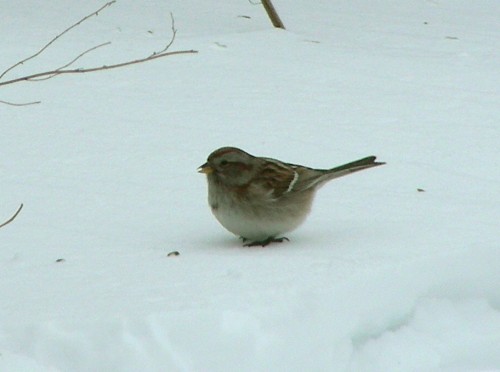 While the northern finches are scarce this winter, the American Tree Sparrows seem to be relatively common compared to past years. They spend most of their time on the ground, foraging on the seed spilled by the chickadees and others above. (Photo by Shawn Craik)
While the northern finches are scarce this winter, the American Tree Sparrows seem to be relatively common compared to past years. They spend most of their time on the ground, foraging on the seed spilled by the chickadees and others above. (Photo by Shawn Craik)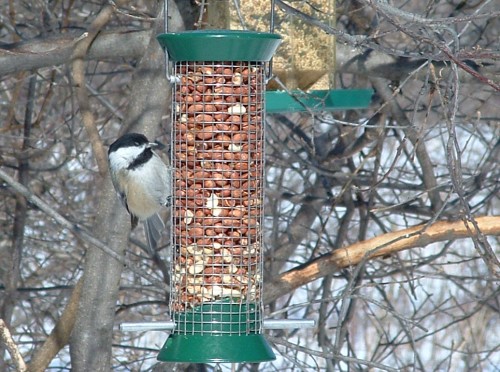 This Blue Jay ‘want-to-be’ provided for some enjoyable observations, as black oil sunflower and nyjer seed are apparently much easier for Black-capped Chickadees to obtain than shelled peanuts. (Photo by Shawn Craik)
This Blue Jay ‘want-to-be’ provided for some enjoyable observations, as black oil sunflower and nyjer seed are apparently much easier for Black-capped Chickadees to obtain than shelled peanuts. (Photo by Shawn Craik)